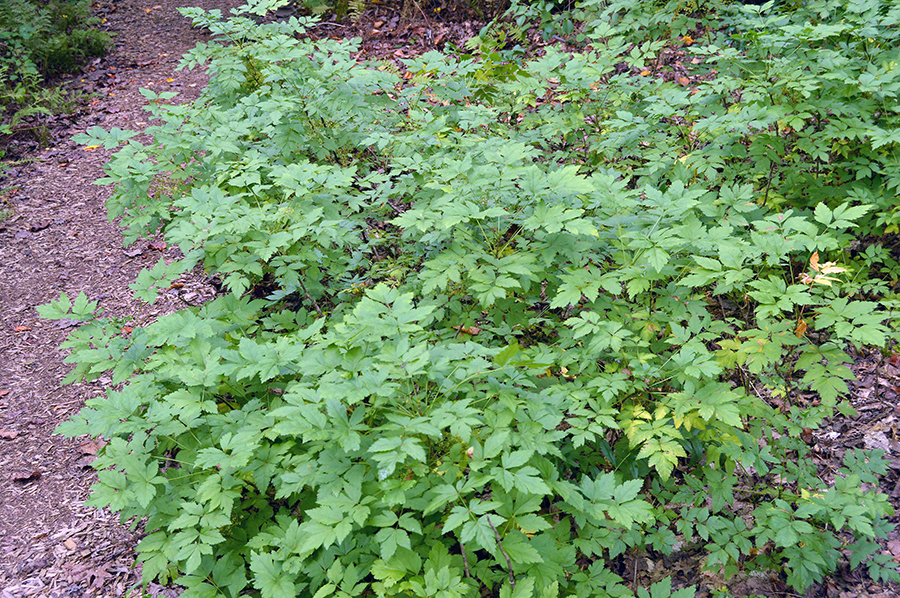Many years back I recall enjoying some pleasant conversation over dinner with a number of horticulturists. One of the individuals at the table turned to my neighbor and inquired what plant, in their opinion, was the best groundcover for the Garden. Without hesitation, the person responded Yellowroot. Dumbfounded, I continued to eat my meal in silence, as I had never heard of this wonderful groundcover. As of this writing, that dinner was 25–30 years ago. I have since seen and used Yellowroot on numerous occasions (see Picture 1) and agree wholeheartedly with that unhesitating response. Yet, I still remain dumbfounded as to why this plant remains unknown to so many!
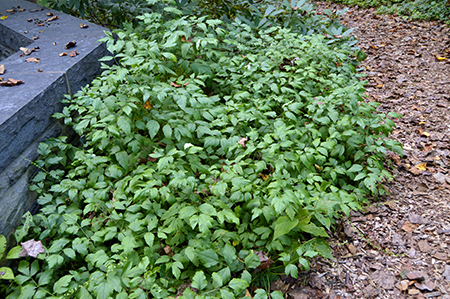
Yellowroot is botanically named Xanthorhiza simplicissima and is a member of the Ranunculaceae or Buttercup Family. With over 43 genera and 2,000 species, Yellowroot is definitely the odd member at family gatherings since it is monotypic, claiming only one species for the genus. It, along with Clematis, are also but a few of the woody members of the family, with the remainder herbaceous plants. Native from Maine to Florida and west to Texas and Ohio, it grows along shaded streambanks and in moist woodlands.
It was first found in 1773 by the American botanist William Bartram (1739–1823) along a steep bank bordering a creek in Buffalo Lick Georgia. He was just beginning a four year journey throughout SE North America when he discovered what he called 'a very curious Little Shrub.' Although William Bartram first discovered the shrub, it was his cousin Humphry Marshall (1722–1801), a stone mason and botanist who eventually described and named the plant in 1785.
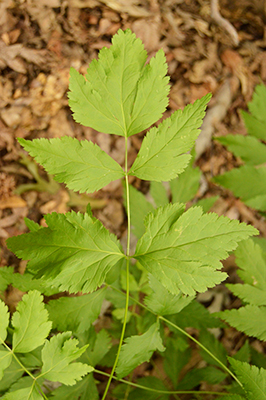
The plants have an 'adventurous' root system that is yellow in color (Picture 4), providing the impetus for both the common name as well as the botanical. Xantho is Greek for yellow and Rhiza for root! The species epithet means 'simple,' describing how the stems are very simple in structure and grow straight upright without branching.
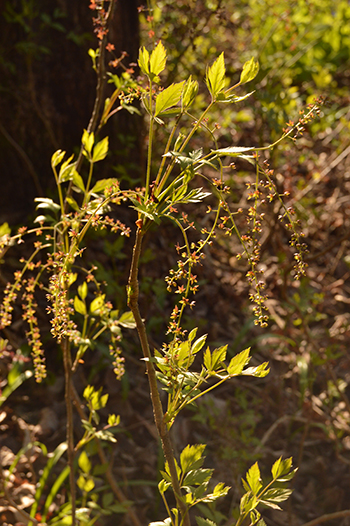
When I finally was able to see a small clump of Yellowroot some years after that dinner, the overall texture of the leaf and form reminded me of celery (Picture 1). The leaf (Picture 2) is pinnately compound, typically with 5 leaflets and growing 4–10" in length. The leaves are alternate and are clustered at the tip of the stems. The leaf scars nearly encircle the stem, falsely giving the impression that the stems are segmented. The foliage often emerges with a bronze tint in early April, quickly turning to deep green for summer and finally golden yellow for the fall (Picture 5).
If the plant is sited in full sun, you can expect attractive red to purple fall colors. In mid to late March and prior to the appearance of foliage, the curious and rather attractive deep purple to chocolate brown flowers appear (Picture 3).
They are often dismissed as being unimpactful, yet when there is little else blooming in the late winter or early spring woodland garden, I find them to be a treat. The individual flowers are roughly ¼" in diameter and are star shaped with 5 pointed flower petals. The flowers are loosely arranged in a radial pattern on branched stems called panicles. The panicles appear at the tips of the stems and initially point upward. As the panicles elongate they grow more lax and become pendant, reaching 2–6" in length at maturity. The flowers persist after the foliage emerges and assume a yellowish green color, before finally vanishing beneath the foliage. They will certainly never compete with the showier spring bloomers, but for those who are detail oriented and like the curious, the flowers are a hit!
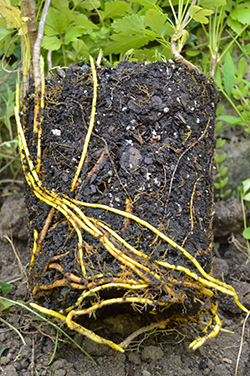
Come fall, the flowers give rise to a dry, single seeded fruit called a follicle. The seeds of the light brown follicles provide food for songbirds and other small animals during the late fall and winter. I have also under-planted masses of Xanthorhiza with some of the early blooming bulbs, such as White Squill (Scilla mischtschenkoana) and Snowdrops (Galanthus nivalis). Even though the plant is fully leafed-out by early May, the bulbs have received sufficient sunlight by this point to develop large bulbs and bloom dependably each year.
The roots and stems get their yellow coloring (Picture 4) from berberine, which is also found in Barberry and Mahonia. It is purported to provide numerous health benefits and although Yellowroot was used by the Native American Indians for various health issues, there remains no conclusive evidence of its effectiveness. Berberine was also used as a dye for fabrics by the early American settlers. Unfortunately, exposure to sunlight often rendered the fabric a far less attractive olive green, with its use in textile industry proving to be rather short lived.
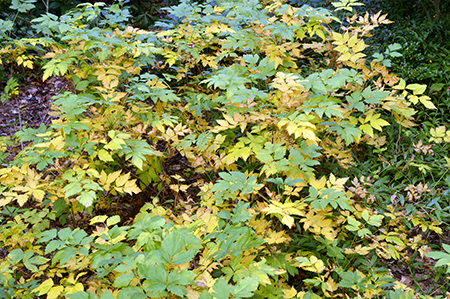
Fortunately, it remains a very successful groundcover and with its hardiness from zones 3–9, it is well suited for the mid-Atlantic region. Although native to shaded locations, I have seen it thrive in full sun as well. In sunny locations, the plant is both denser and shorter, reaching heights of around 18" tall. In shade, the plant is more open in habit and grows to 24–30" tall. In both instances it provides effective competition for weeds. It is also a great plant for garden locations that transition from shade to sun during the day. Since it is native to banks adjacent to streams, it is ideal for soil stabilization and can endure extended periods of flooding. Conversely, it is also drought tolerant and can persist in compacted soils, conditions that are typically found in flood plains. In theory, the plant could spread indefinitely since it is very long lived and plantings at the Arnold Arboretum have thrived for over 100 years! The spread is slower in dry, sandy or gritty soils. I have observed a planting in a woodland garden (Picture 6) with well-drained soils for over 20 years and the plants have politely remained within their boundaries. In moist soils, the plants are more vigorous. Plants are adaptable to the soil pH, although in more alkaline conditions, the foliage will become chlorotic, assuming a yellow coloration with dark green veins. The relatively dense cover that the plant provides also makes it a great habitat for ground nesting birds when used in larger masses.
What I have found strikingly unusual is how this 'curious Little Shrub' has received positive praises and reviews from the very moment Bartram made the initial discovery and yet after nearly 250 years, it remains a rarity in nurseries and in gardens. I am hopeful that during your next gathering with gardeners, should someone inquire about a great native groundcover for their garden, without hesitation you will suggest Yellowroot. It truly is a curious and great groundcover!